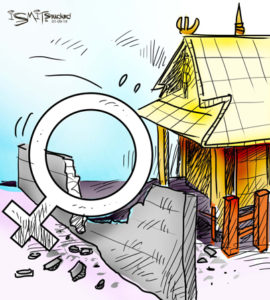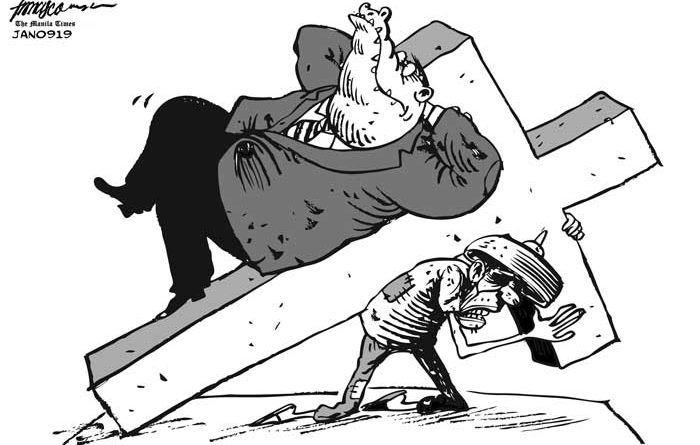OP ED EDITORIALS & CARTOONS: … JUAN DELA CRUZ BIGGEST BURDEN
EDITORIAL
Traslacion and its misconceptions
Apart from the darkened image of the Christ carrying a cross on the way to Calvary, what has attracted curiosity is the enormous crowd of barefoot, towel-waving Catholic faithful jostling for the opportunity to touch the centuries-old wooden icon, or even the rope pulling its carriage.

Despite its popularity and media’s wall-to-wall coverage of the Traslacion, the feast continues to be surrounded by misconceptions.
It is not the feast of the Black Nazarene, but a procession commemorating the solemn transfer of the image to Quiapo Church (now minor basilica) from the old San Nicolas de Tolentino Church in Intramuros, Manila, in 1787.
In Catholic tradition, feasts are governed by liturgical books, and according to the liturgy, the feast of the Nazarene is properly observed on Good Friday during the triduum (three days) of Holy Week. The same liturgy books dictate that the fiesta of Quiapo as a parish should be observed on June 24, because the church itself is canonically dedicated to St. John the Baptist.
History aside, another big misconception is that Nazareno devotees are engaging in idolatry or the worship of graven images, which is against biblical injunction.
Those who dismiss the Traslacion as a modern-day “worship” of the golden calf have a very poor understanding of Catholic belief and practices.
There is a clear distinction between sacramentals, which are holy objects, and sacraments, which are channels of grace.
Sacramentals “are sacred signs which bear a resemblance to the sacraments,” according to the Catechism. “They signify effects, particularly of a spiritual nature, which are obtained through the intercession of the Church. By them, men are disposed to receive the chief effect of the sacraments, and various occasions in life are rendered holy.”
The Nazareno image is a sacramental, a holy object that serves as a reminder of God’s protection, mercy and love. That multitudes attribute healings and miracles to the icon attests to the work of God through objects of his creation, much like the bleeding woman healed after she touched the fringe of Christ’s cloak. It is not a sacrament like baptism or confirmation, which bestows sanctifying grace upon the receiver.
Another distinction that has to be made is between veneration and worship. In Catholic belief, veneration is not the same as worship. Veneration is the due honor and respect accorded to saints, and the images of saints and even of God. It is no different from the honor and respect due to national heroes.
Joining the Traslacion and touching the image or the rope of its carriage is veneration, not worship. Worship, or adoration, is reserved to God alone.
Even in the ancient religions, worship is distinguished by the sacrifices it entailed for the atonement of sins. In pagan rituals, it meant the sacrifice of human life, usually a virgin. Others, such as the Jews, offered animal sacrifices.
In Catholicism, the Holy Mass is the new sacrifice, during which Christ’s death on the cross is presented anew. In the new sacrifice, no human life is taken away, as pagan sacrifice is not enough to atone for sin. In this new form of worship, no one can partake of the meal without reconciliation with God and the grace of the sacraments.
Today, the procession is preceded by Masses and round-the-clock confessions, with the Quiapo priests making it a point to ensure the proper religious orientation of the Traslacion. Above all, the Traslacion is a religious festival that must bring its participants closer to God.
ASEANEWS EDITORIAL & CARTOONS:
7.1.DAILY TRIBUNE- Hot potato- DAILY TRIBUNE / – CONCEPT
– Manila’s lost glory
7.2. Manila Bulletin – Japan needs foreign workers in many fields
.
– SPACE RESERVE FOR YOUR ADVERTISEMENT –
.
.

7.4 The Manila Times – ….JUAN DELA CRUZ BIGGEST BURDEN


7.6 The Philippine Star – Safe worship

7.7. Pilipino STAR Ngayon – Mga korapsa Gabinete


The Straits Times says
Challenges for Earth? Watch this space
The successful landing of China’s lunar probe on the far side of the Moon is the latest human achievement in space exploration. The erstwhile Soviet Union inaugurated the Space Age in 1957 with the successful launch of Sputnik I, the world’s first artificial satellite. The event spurred on the United States to stay in the space race, a momentum that led ultimately to the Apollo 11 mission which landed the first men on the Moon in 1969. Now, China has surpassed the remit of lunar investigations by landing the Chang’e-4 to discover what lies on the mysterious “dark side” of the Moon. While the US and Russia can launch similar landings on the far side, China got there first and, not unexpectedly, celebrated its latest significant technological accomplishment.
China has demonstrated that lunar exploration is not the preserve of any one nation, cultural system or ideology. Much as Sputnik put the world on notice about the technological abilities of the then Soviet Union, which in turn enhanced its economic and strategic capabilities, the Chang’e-4 landing showed that China’s path to modernisation is well on its way. Even countries that do not share China’s political model and strategic goals are heartened by its scientific achievements. The Moon is neutral to the terrestrial ideologies that make humans strive to reach it.
TO READ THE FULL ARTICLE:
https://www.straitstimes.com/world/challenges-for-earth-watch-this-space 09dec19
.

ADS by Cloud 9:
.
– SPACE RESERVE FOR YOUR ADVERTISEMENT –
.
.
 All photographs, news, editorials, opinions, information, data, others have been taken from the Internet ..aseanews.net | [email protected] |.For comments, Email to :D’Equalizer | [email protected] | Contributor
All photographs, news, editorials, opinions, information, data, others have been taken from the Internet ..aseanews.net | [email protected] |.For comments, Email to :D’Equalizer | [email protected] | Contributor












